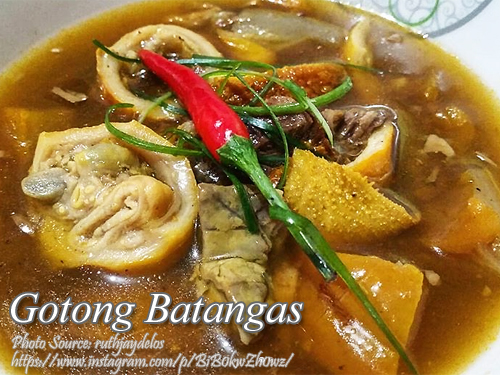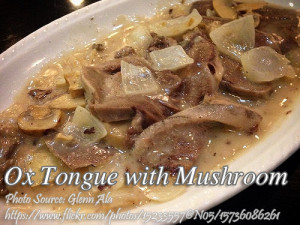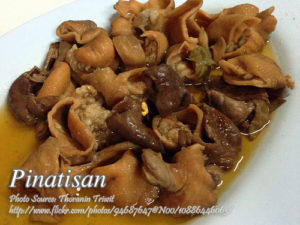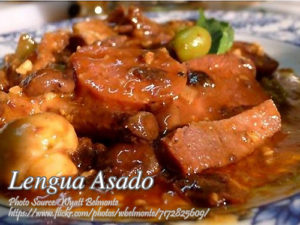Gotong batangas is a unique kind of goto where the it differs from the goto we all know which consists of rice gruel or porridge with beef tripes. This dish is very similar to “beef papaitan” where it is a soup with beef innards. The beef innards used is usually beef tripe and combined other innards such as beef intestines, kidney, heart and liver. But some also used beef skin and parts of the cow’s head such as cheeks and tongue.
If you have visited Lipa City in Batangas specifically the Lipa pulic market almost all the cooked food sellers serve this kind of goto and they vary on the cow parts used in this dish. You can also request what kind of beef innards you want to put in your bowl. One tip I’ve learned to make your goto tasty, you should use rice washing instead of water in cooking the beef innards. To make the rice washing, just collect the liquid from washing of the uncooked rice.
Gotong Batangas: A Taste of Home in Every Bowl
If there’s one dish that always takes me back to my childhood visits to Lipa, it’s gotong Batangas. Unlike the familiar rice porridge-based goto, this hearty soup is all about rich beef innards swimming in a flavorful broth. Growing up, I often heard my Lola Nena rave about how the secret to an unforgettable bowl of goto lies in the simplicity of its ingredients and the love poured into its preparation. Every sip brings a sense of nostalgia, making it more than just a meal—it’s a comforting reminder of home.
A Dish Rooted in Batangas Tradition
Gotong Batangas is more than just food; it’s a cultural icon in the province. My first taste was at the Lipa Public Market, where nearly every carinderia seemed to have their own version. Tito Ramon, who knew all the best spots for local delicacies, swore by a tiny eatery tucked in the market’s corner. There, the vendors would let you customize your bowl by choosing your preferred cuts—beef tripe, intestines, kidneys, or even a mix of everything. Some adventurous eaters even added beef cheeks and tongue for extra texture and flavor.
The dish’s origins are closely tied to the resourcefulness of Batangueños, who waste nothing from their cattle. By using innards that might otherwise be discarded, they’ve created a soup that’s hearty, flavorful, and utterly unique. The iconic dish doesn’t just fill your stomach; it tells a story of Batangas’ culinary ingenuity.
The Secret to a Flavorful Gotong Batangas
One of the most valuable cooking tips I learned came from my Tita Rose, who is a master at making this dish. She insisted that instead of water, you should always use rice washing as the base for the broth. Rice washing—or the milky liquid left after rinsing uncooked rice—adds a subtle depth to the soup, enhancing its earthy flavor. She said this small step makes all the difference, and after trying it myself, I couldn’t agree more.
The process of preparing gotong Batangas might seem daunting for beginners, but once you break it down, it’s straightforward. The key is in properly cleaning the beef innards. My Kuya Jun, who once worked as a cook in Lipa, taught me the importance of rubbing the innards with rock salt and vinegar. This technique not only removes impurities but also eliminates any unwanted odor, leaving you with clean and tender ingredients ready to absorb all the rich flavors of the broth.
Cooking Gotong Batangas the Traditional Way
Making gotong Batangas at home requires time and patience, but trust me—it’s worth every effort. The process begins with boiling the beef innards, tripe, and other cuts like beef cheeks and kidneys in a pot with aromatics like bay leaves, garlic, and ginger. The aroma of the simmering broth brings back memories of lazy Sunday mornings at home, where the kitchen was always filled with the comforting scent of home-cooked meals.
Once the meat is tender, it’s sautéed in garlic, onion, and ginger to add an extra layer of flavor. Annatto powder is added for that signature warm, golden hue, and a touch of vinegar gives the dish its slightly tangy kick. Finally, everything is returned to the pot, allowing the flavors to meld beautifully.
The finishing touch? A generous squeeze of calamansi, a sprinkle of freshly chopped onions, and a dash of siling labuyo for heat. These simple additions brighten the dish, balancing the richness of the broth and the meat.
Food for Thought: A Dish for All Seasons
What I love most about gotong Batangas is how versatile it is. Whether enjoyed as a hearty breakfast, a midday pick-me-up, or a late-night snack, it never fails to warm the soul. Its robust flavors reflect the strong and resilient spirit of Batangueños, making it a dish that’s as much about identity as it is about taste.
Did you know that the name “goto” traditionally referred to rice porridge with tripe? Over time, Batangas put its unique spin on the dish, creating a version without rice but with an even richer, meatier flavor profile. This adaptation speaks to the creativity and adaptability of Filipino cuisine, which takes the familiar and transforms it into something extraordinary.
Why You Should Try Gotong Batangas
If you’ve never cooked gotong Batangas before, don’t be intimidated. It’s a rewarding dish to make, especially when you see how your family gathers around the table to savor every spoonful. It’s the kind of recipe that brings people together—whether you’re reminiscing about childhood market visits or simply sharing stories over a warm, comforting bowl.
The next time you’re craving something hearty and uniquely Filipino, consider giving it a try. It’s a taste of tradition, a celebration of resourcefulness, and, most importantly, a reminder that the simplest dishes often hold the most meaning.
How to Cook Gotong Batangas
Ingredients
- 500 grams beef tripe
- 250 grams beef cheeks or any beef cuts
- 250 grams beef small intestine
- 250 grams beef kidney
- 1/2 head garlic, crushed
- 1/2 head garlic minced
- 1 pc onion minced
- 1 pc bayleaf
- 1/2 tsp. peppercorns
- 1 1/2 cup of vinegar
- 1 thumb sized ginger julienned
- 1 thumb sized ginger crushed
- 1 tsp. annato powder
- 1/2 Tbsp. rock salt
- 2 Tbsp. cooking oil
- 3 1/2 liters rice washing or water
- salt and pepper to taste
Instructions
How to cook Gotong Batangas:
- Clean beef tripe and intestines by rinsing in running water and rub with rock salt. Pour vinegar about one cup on the both innards and let is stand for about 15 minutes. Use a knife or a brush to clean the green stuffs on the tripe and other impurities.
- Rinse in running water and parboil for about 15 minutes. Discard water and rinse again and drain.
- Put water in the pot and add all the meat ingredients such as tripe, beef cheeks, intestines and kidney then bring to a boil. Add also the bay leaf, crushed garlic, crushed ginger, 1/2 tablespoon rock salt and peppercorns. Adjust heat to medium and as soon as the scum floats on the surface, remove them.
- Then lower the heat and simmer until tender approximately 1 and 1/2 hours to 3 hours. When tender, remove the meat, tripe and innards from the broth and slice into strips.
- In a pan, heat oil and saute garlic, onion and ginger until fragrant. Then saute the meat, tripe and innards for about 3 minutes. Then add the annato powder and half a cup of vinegar. Stir for another 2 minutes.
- Then put the sauteed meat and innards in the pot of broth and cook in medium heat for another 10 minutes. Season with salt and pepper.
- Transfer in individual serving bowls and serve hot with chopped onions, calamansi and siling labuyo.
Notes
Cooking Tips:
Masterful Meat Marination: Infusing Flavor at Its Best
Marinating meat is a culinary art that can elevate your dishes to new heights. To maximize flavor absorption, create a well-balanced marinade. Start with an acid component like vinegar or citrus juice to tenderize the meat. Add flavorful elements such as minced garlic, herbs, and spices for depth. Allow ample time for marination; for tougher cuts, extend marinating time to tenderize. Remember to refrigerate, letting the flavors meld. When grilling or roasting, pat the meat dry to promote a flavorful crust. Your patience in marinating will be rewarded with succulent, restaurant-quality results.The Science of Searing: Achieving Perfect Caramelization
Searing isn't just about locking in juices; it's the key to incredible flavor through caramelization. Choose a heavy, oven-safe pan for an even sear. Pat the meat dry to remove excess moisture, ensuring a golden crust. Preheat the pan until it's smoking hot. Add oil with a high smoke point to prevent burning. Lay the meat, ensuring space between pieces for optimal browning. Resist the urge to flip too early; let the Maillard reaction work its magic. Searing imparts a complex, nutty flavor to your dish, transforming ordinary meals into culinary delights.Flavorful Foundations: Crafting the Perfect Stock
A well-crafted stock is the secret weapon in many exquisite dishes. Begin with quality ingredients – bones, vegetables, and aromatics. Roasting bones before simmering enhances depth. For a clear stock, start with cold water, gradually heating to draw out flavors. Skim impurities that rise to the surface. Add vegetables and herbs during the final hours for freshness. Simmer gently; boiling can cloud the stock. Strain meticulously for clarity. Freeze in portions for convenience. A homemade stock forms the backbone of remarkable soups, sauces, and stews, imparting a rich, nuanced taste that store-bought versions can seldom match.Nutrition Notes:
Calorie and other nutrition information is derived from HappyFolks.Com recipe nutrition calculator. The percent daily value (%DV) is based on a daily 2,000 calorie diet.Nutrition Facts:
Amount per Serving:933g, Calories:309kcal, From fat:108, Total fat:12.2g, Saturated Fat:6.6g, Trans Fat:0.3g, Cholesterol:415mg, Sodium: 833 Total Carbohydrate: 11g, Dietary Fiber: 1g, Sugars: 4g, Protein: 36g, Vitamin A: 154%, Vitamin C: 46%, Calcium: 12%, Iron: 33%





